Plantain, Banana Uses, Research, Remedies, Side Effects
Kadali- Musa paradisiaca is mentioned in Ayurveda for the treatment of cholera, hysteria, bleeding disorders, seminal debility, vaginal discharge, burning sensation, general debility.
Latin name- Musa paradisiaca Linn.
Family- Musaceae
Table of Contents
Home remedies
By Dr MS Krishnamurthy MD (Ayu), PhD
Different parts of banana tree – ripe fruit, unripe fruit, leaves, tender leaf, rhizome and flower are used as remedies and dishes. Apart from its nutritional value it has quite a lot of preventive and curative health benefits too.
Ripe banana remedy
Banana ripe fruit remedy for cold and allergy:
The fruit is peeled and inner pulp is taken.
This is incised and in the incised area 2-3 long pepper fruits or 10-12 pepper seeds are placed and wrapped. This is kept in a tray and exposed to the moon light by keeping it over the terrace during night (especially on full moon day).
Next day morning, it is consumed on empty stomach. Procedure is repeated daily for 10-12 days. This helps to reduce the incidences of seasonal cold, rhinitis, cough etc. In few tropical eosinophilia cases also its good effect is experienced by me.
In Maharashtra this kind of practice is found by folklore.

Banana peel remedy
Banana peel remedy for abscess:
Banana skin is cooked with lime water (calcium hydroxide). Further this is macerated well and fine paste is made. This paste is applied over abscess (externally, leaving out the opening / punctum of the abscess). This practice helps to mature the abscess easily. It enables quicker pus formation, which is later drained out by incision.
Unripe banana remedy
Banana unripe fruit remedy for chickenpox scars:
Unripe fruit (as being used for vegetable) skin is taken and it is burnt. The black colored charred substance hence obtained is mixed with turmeric paste and applied over the lesions of chicken pox. This helps to reduce the scars and discoloration.
Read related: Banana milkshake for tiredness and fatigue
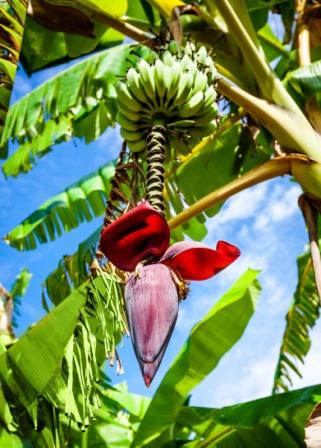
Banana flower remedy
Banana flower remedy for gastritis:
One fistful of flower is taken and 1 cup of water is added. It is crushed or put in mixer and fresh juice is extracted.
To this, 1 tablespoon of of honey is added and consumed early in the morning. This reduces gastritis as well as heaviness of the body.
In few of the individuals it may cause tastelessness (anorexia) and in such a case 1 spoon of cumin seed is added to this juice.
Read related: Banana flower Sabji For Pitta Balance, Stomach Pain, Worms [Video]
Banana stem remedy
Banana stem tube for urinary calculi:
Daily intake of 15 – 20 ml fresh juice of the tube helps to reduce the chances of occurrences of urinary stones. It is useful in treating burning urination as well.
Banana rhizome remedy
Banana rhizome for white discharge (leucorrhea):
The rhizome (root part) – 100 grams is cooked well by adding 50 grams of jaggery. Then it is made into fine paste.
To this paste, a teaspoon of ghee is added and constantly stirred in mild intensity of heat till we get semisolid consistency (paste). Later it is taken out of the fire and on self cooling little honey is added and mixed thoroughly.
This can be kept for 2-3 months.
5-10 gram of this linctus is taken along with food daily (similar to a fruit jam). This is a very good nutritive and rejuvenator and anti ageing. This is effective in non specific leucorrhoea cases.
Banana leaf remedy
Banana leaf remedy for morning sickness:
The mature leaf is taken and burnt in open air to obtain the ash.
This ash is mixed with honey in equal proportions. Half a teaspoon of this is given to lick to the pregnant mother. This reduces morning sickness and hiccup caused in old age.
Banana Tender leaf remedy for gastritis:
Ghee is smeared over the tender leaf and warm food is served over this. Before completely cooling down, the served food is consumed. This helps to pacify the gastric irritation caused in the patients of gastric and duodenal ulcer.
Feel the pleasure of tradition, age old practices and its health benefits.
Science and rationality exists among all these traditional practices. Only thing lacking is, appreciation and finding the mode of action with modern pharmacological methods.
Click to consult Dr MS Krishnamurthy

Banana flower Sabji
Banana flower is astringent and balances Pitta. One of the best ways to use banana flower is to make a Sabji out of it and use as a part of diet.
video
Ingredients
Ingredients
Banana Flowers – 1
Butter milk – 1 cup
Jack fruit seeds- 8 to 10 (optional)
Salt- 1 teaspoon or as per taste.
Jaggery – 5 grams
Water – 2 cups
For masala –
Red chilli- 3
Mustard seeds- ¼ tea spoon
Grated coconut- 3/4 cup
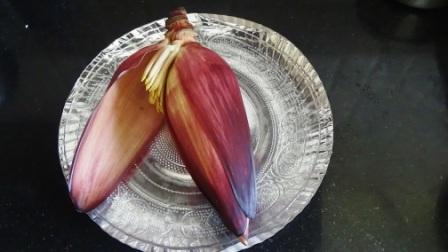
For seasoning
Mustard seeds- 1 tea spoon
Urad dal ( black gram) – 2 teaspoon
Red chilli – 2
Vegetable oil (sunflower oil / coconut oil) – 2 tablespoon
Curry leaves- 10 to 15
Method of preparation
Cut the banana flowers into small pieces and soak it in a bowl of water for 15 minutes.
After 15 minutes, prepare seasoning.
For this, take a frying pan and add 2 tablespoon oil, mustard seeds, black gram and chopped red chilli. Start heating in mild fire.
While heating, when the above ingredients start popping out, add curry leaves.
This is the general method of preparation of seasoning (Oggarane in Kannada).
Immediately after adding curry leaves, add the soaked banana flowers to this seasoning, add the optional crushed Jack fruit seeds, a cup of butter milk, 2 cups of water, jaggery and close the lid. Cook for 10 minutes.
While cooking, separately prepare a masala paste.
Take grated coconut, red chili, mustard seed in a mixer and grind to prepare a coarse paste.
Add this paste and salt to the cooking pan containing banana flower and other ingredients. Continue cooking in closed lid till there is no free water left in the pan.
Your banana flower Sabji is ready to serve.
Benefits
This carries all the health benefits of banana flower.
Banana flower is attributed with the following qualitie:
Krumihari – useful in intestinal parasites and worms
Shishira – it is a natural coolant,
Kashaya – astringent in taste
Pittapaha – balances Pitta
Ruchya – improves taste, useful in anorexia
shoolashamaka – relieves abdominal pain associated with dyspepsia and bloating.
It can be used by pregnant, lactating mother and children.
Related:
Ayurvedic Pitta diet
Home remedies for acidity and gastritis
Properties, part used, dosage
Properties:
Rasa (Taste) – Madhura (Sweet), Kashaya (Astringent)
Guna (Qualities) – Guru (Heavy for digestion), Snigdha (Slimy in nature)
Vipaka – Madhura (Undergoes sweet taste after digestion)
Veerya (Potency) – Sheeta (Cold)
Karma (Actions) – Vatapitta shamaka (reduces vitiated vata and pitta dosha), Kaphavardak (Increases kapha dosha)
Read related: Banana flower Sabji For Pitta Balance, Stomach Pain, Worms [Video]
Karma: Since heavy for digestion not to be consumed by persons with low digestive agni; provides instant energy soon after ingestion; appeases the hunger in person with strong digestive agni; provides nourishment.

Properties as per Bhojana Kutuhalam
According to Bhojana Kutuhalam eleventh chapter, The bulb of plantain is strengthening, alleviates kapha and pitta and is heavy for digestion. It aggravates vata and pacifies diseases of blood, astringent, dry and cold. In the plantain section the properties of its different varieties are mentioned.
Tender Plantain
It is sweet and slightly astringent in taste, The stem alleviates pitta dosha, Is cold in potency and improves taste perception. Its flower almost has the similar properties and its bulb is useful in treating intestinal worms and the leaves checks the colicky pain.
Mature Plantain
Mature plantain is astringent and sweet in taste, Is strengthening and cold in potency. It is helpful in pitta and rakta related conditions, It is very heavy for digestion and hence not advisable for people with weak digestive fire. It increases virility instantly and treats intestinal worms, relieves thirst, imparts good complexion. It is appetizing in nature, nourishes the body, helps in treating kapha related disorders, is digested with difficulty and is specially advised for people with good digestive fire.
Mahakadali
The Maharambaphala is cold in potency, helps in nourishing and strengthening the body and is heavy for digestion. It treats bleeding disorders, aphrodisiac and advised for persons with strong digestive capacity.
Kashtakadali
It improves taste perception, checks bleeding disorders and is cold in potency. It is sweet in taste and heavy for digestion.
Small plantain
The small plantain is cold in potency, becomes sweet in its post metabolic effect and is heavy for digestion. It treats pitta vitiated conditions, pradara, burning sensation and mildly stimulates the digestive fire.
Girikadali
The girikadali or the wild plantain has cold potency, sweet taste, imparts strength and virility and improves taste perception. Helps to treat thirst, aggravated pitta dosha, burning sensation and is heavy to digest.
Krishnarambhaphala
It promotes growth, aggravates vata dosha, Is light for digestion and treats meha, pitta related conditions and thirst.
The skin of plantain is pungent and bitter in taste, light for digestion and alleviates pitta dosha.
Varieties
Bh. Pr – 4 types
Manikya kadali
Martya kadali
Amruta kadali
Champaka kadali
Ka. Ni – 3types
Sugandha kadali
Krishna kadali
Sita kadali
Varieties of plantain and banana and their qualities:
There are many sub varieties of plantain and Bananas. All in all, more sweet the fruit is,
– more kapha increasing it is,
– heavier to digest
– more Pitta and Vata balancing
– more unsuitable during cough, cold and asthma.
– more suitable during gastritis, burning sensation, constipation, bloating.
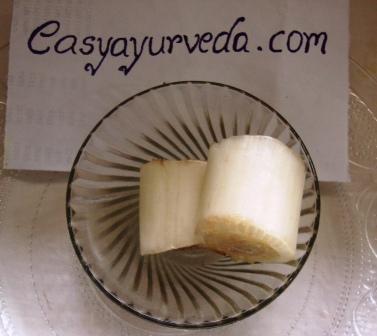
Part used, dosage
Part used- Fruit, Stem, Flower
Dosage-
Juice of stem- 10 to 20 ml
Ash of stem- 1-2 g
Chemical composition
Chemical composition of Musa paradisiaca:
The ripened fruit of Banana contains about 22% sugar, starch, albuminoid, Vitamin C, B and A. An anti-ulcerogenic acylsteryl glycoside, sitoindoside IV, has been isolated from unripe banana. A pectin containing hexoses (32.4%) and uronic acid (52.5%) has been isolated from the pith of the stem.
Read related: Banana Milkshake Remedy For Tiredness And Fatigue
Uses, Sanskrit verse
Medicinal uses of banana:
- The pulp of the fruit and flowers of kadali is applied over burnt injuries as part of treatment.
- The juice of banana stem is given in a dose of 20-25 ml to treat renal calculi and leucorrhea.
- In conditions of dysuria, the paste of the root of rhizome of Musa paradisiaca is applied over the lower abdominal area.
- In cases of skin infection and eczema, the ash of burnt stem of banana plant is mixed with turmeric powder and applied over the affected area.
- The ripened fruit of Kadali is given in dry cough but can be avoided in productive cough.
- Fresh juice from the stem of Musa paradisiaca is given in a dose of 15-20 ml to treat cases of hysteria, burning sensation and dehydration.
- The fresh juice of the stalk of Banana plant acts as antidote for morphine and arsenic toxicity.
- The ripened fruit of banana is beneficial to treat cases of seminal debility, vaginal discharge and general debility.
- The stem of the Kadali plant is eaten raw or made into salad and consumed to treat cases of constipation and burning sensation during micturition.
- Raw banana is given to treat cases of cholera.
- The flowers of banana is consumed to treat hyperacidity.
- Raw and ripened banana is used for many culinary items and desserts all over the world.
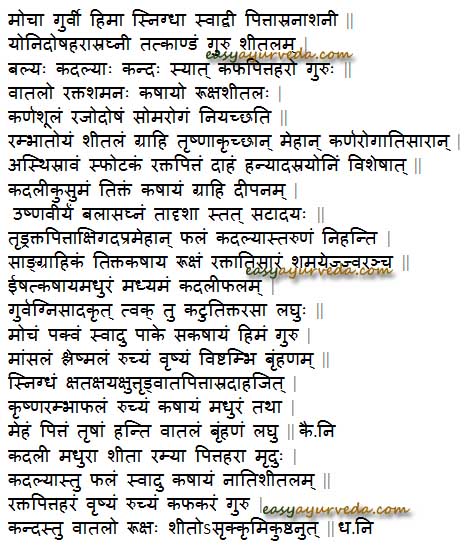
Banana uses as per Ayurveda:
Ripe banana / plantain Fruit:
Guru – heavy to digest
Hima – coolant
Snigdha – unctuous, oily
Svadu – sweet
Vrushya – aphrodisiac, improves vigor
Brumhana – nourishing, nutritious
banana fruit indicated in –
Pittasra – Raktapitta –Bleeding disorders such as nasal bleeding, heavy periods, etc
Kshatakshaya – chest injury
Kshut – excess hunger
Trut – excessive thirst
Pittasra – Raktapitta –Bleeding disorders such as nasal bleeding, heavy periods, etc
Daha – burning sensation, as in gastritis, neuropathy, burning sensation in eyes etc.
Instantly increases sperm / semen production
Kantida – improves skin tone and complexion
Durjara – takes a long time to undergo digestion
Black banana fruit:
Ruchya – improves taste, relieves anorexia.
Kashaya – astringent
Madhura – sweet
Indicated in –
Meha – diabetes, urinary tract disorders
Pitta disorders
Trushna – excessive thirst
Vatala – increases Vata Dosha
Brimhana – improves weight
Laghu – light to digest
Banana stem:
Guru – heavy to digest
Sheeta – coolant
Rooksha- Dry
Grahi- hardens the stools
Balances Kapha Pitta Dosha
Indicated in –
Yonidosha – gynecological disorders
Asra – blood disorders such as abscess, skin disorders, bleeding disorders such as menorrhagia, nasal bleeding etc.
Karnashoola – Earache
Rajodosha – gynecological disorders
Keshya – Improves hair strength, promotes hair growth
Amlapitta – acidity, gastritis, acid peptic disorder
Prameha
Rambha Toya – juice extract from stem:
Sheetala – coolant
Grahi – absorbent, useful in diarrhea, IBS
Indicated in –
Trushna – excessive thirst
Mutrakrichra –Dysuria, urinary retention
Meha – diabetes, urinary tract disorders
Karnaroga – ear disorders
Atisara – diarrhoea, dysentery
Sphotaka – boils
Asthisrava – deep abscess
Raktapitta –Bleeding disorders such as nasal bleeding, heavy periods, etc
Daha – burning sensation, as in gastritis, neuropathy, burning sensation in eyes etc
Banana inflorescence / Banana flower benefits:
Tikta – bitter
kashaya – astringent
Grahi – absorbent, useful in diarrhea, IBS
Deepana – improves digestion strength
Ushna Veerya (potency) – hot
Kaphahara – balances Kapha, useful in productive cough, asthma, bronchitis, chest congestion
Raw banana fruit benefits:
Indicated in –
Trushna – excessive thirst
Raktapitta –Bleeding disorders such as nasal bleeding, heavy periods, etc
Akshiroga – eye disorders
Prameha – Urinary tract disorders, diabetes
Rakta Atisara – diarrhoea, dysentery with bleeding
Jwara – fever
Semi ripe banana fruit:
Ishat Kashaya Madhura – slightly sweet and astringent
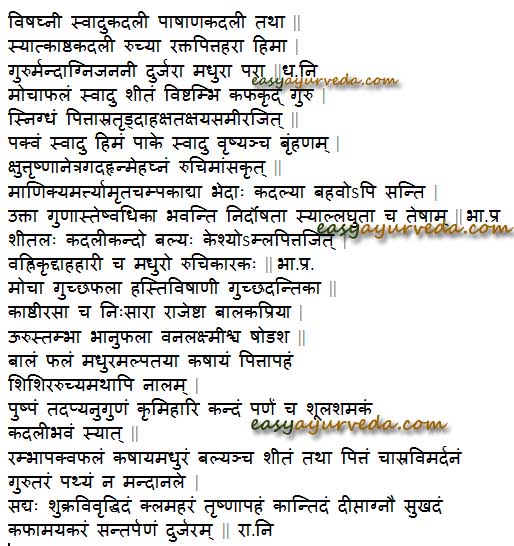
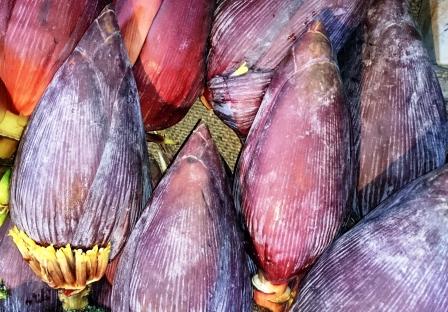
Side effects
Side effects of Banana:
Ripe fruit takes long time to digest and can increase Kapha. Hence, it is not ideal during low digestion strength, during cold, cough and asthma.
Interaction with medicines, supplements
Can this be used while taking Homeopathic medicine?
Yes. This product does not react with homeopathic medicine.
Can
this medicine be continued while taking supplements like multivitamin tablets,
Omega 3 fatty acids etc?
Yes. Generally, this product goes well with most
of the dietary supplements. However, if you are taking more than one product
per day, please consult your doctor for an opinion.
With western
medicines
Seek your
doctor’s advice if you are taking this product along with other western
(allopathic / modern) medicines. Some Ayurvedic herbs can interact with modern
medicine.
If both Ayurvedic and allopathic medicines are advised together, then it is
best to take Allopathic medicine first, wait for 30 minutes and then take the
Ayurvedic medicine.
Ayurvedic medicines
Ayurvedic medicines containing Kadali:
Kshara taila: It is a herbal oil, used externally in the treatment of tinnitus, ear ache, hearing loss, worm infestation etc.
Balamritam: It is widely used as a general tonic for children. It promotes growth, immunity and appetite in children. It is a fermented Ayurvedic product.
Panaviraladi bhasma: It is a ayurvedic medicine used in the treatment of edema and ascites. It is in powder form.
Himasagara taila: It is an Ayurvedic oil used in various neuro-muscular conditions, locomotor problems, chest injury, emaciation, muscle wasting, locked jaw, frozen neck, frozen shoulder, speech difficulties and Vata diseases.
Madana Kameshwari lehya: This formulation helps to improve sperm count, improves sperm and semen quality and quantity. It is a good natural aphrodisiac. This keeps the mind active, helps to forget worries, and maintain enthusiasm.
Vasant kusumakar Rasa: This is a medicine used in treatment of diabetes, diseases related to urinary tract, memory loss etc.
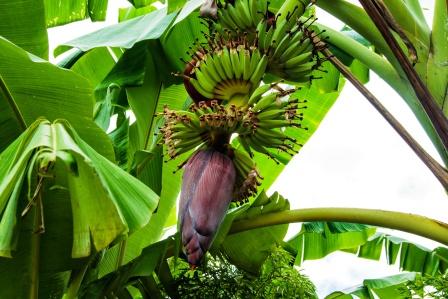
C- Health granule: It is a proprietary Ayurvedic medicine. It promotes overall health and provides sense of well-being. It reduces cellular damage caused by free radicals and reduces physical exhaustion and mental stress.
Banana leaf benefits
Banana leaf is traditionally used as plate for having food. It has calming effect and aides in digestion.
Banana leaf wrap is a famous Spa treatment wherein the banana leaves are wrapped around the patient’s body. This is known to improve energy levels and induces relaxation.
Banana leaf juice is applied externally to treat dandruff and dermatitis.
Banana leaves juice – 20-30 ml is mixed with a pinch of each of ginger, black pepper and rock salt. Mixed well. If needed, sugar can be added for taste. This is advised for the treatment of cold, cough, asthma, weak digestion and vomiting sensation.
Research
Research articles related to Musa paradisiaca:
Anti- urolithiatic property: The objective of investigation was to evaluate urolithiatic property of Musa stem juice. By the three month invitro analysis it was proven that the Musa stem juice is effective to dissolve kidney stone. The experiment is carried out in in-vitro condition.
Biological activities of Banana flower: In the present study we have evaluated the anti- oxidant, anti-inflammatory and anti-obesity activities of banana flower extract. From the results obtained, it can be concluded that the flower extract of banana revealed promising antioxidant, anti-inflammatory and anti-obese effects due to significant total phenol content.
The ethanolic extracts and the hexane and chloroform fractions of leaves and fruit peels showed promising anti-diabetic activity in STZ-s model. Further the isolated compounds from the active fractions did not show the anti-diabetic activity.
Anti- ulcer activity: The aqueous extract of leaves of Musa paradisiaca was prepared by hot maceration and then it was subjected to preliminary phytochemical investigation. Then antiulcer efficacy of aqueous extract of leaves of Musa paradisiaca at 250 and 1000 mg/kg dose level was evaluated by aspirin induced model. The aqueous extract at both the dose levels was found to possess significant antiulcer activity in this model.
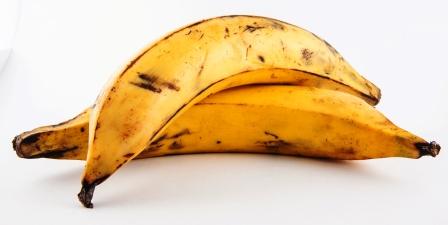
Anti- hypertensive action: This study was done earlier in Musa paradisiaca in albino rats. Later scientists reported that banana diet can reduce mean arterial blood pressure as well as onset preventing effect in rats with elevated blood pressure treated by desoxycorticosterone acetate (DOCA). Apart from effect in blood pressure, banana inhibits atherosclerosis and gallstones in vivo.
Morphology
Morphology of Musa paradisiaca:
The banana plant is the largest herbaceous flowering plant. All the above-ground parts of a banana plant grow from a structure usually called a “corm”. Plants are normally tall growing to a height of 1-4 m and are often mistaken for trees, but what appears to be a trunk is actually a “false stem” or pseudostem. The leaves of banana plants are composed of a “stalk” (petiole) and a blade (lamina). When a banana plant is mature, the corm stops producing new leaves and begins to form a flower spike or inflorescence. A stem develops which grows up inside the pseudostem, carrying the immature inflorescence until eventually it emerges at the top. Each pseudostem normally produces a single inflorescence, also known as the “banana heart”. The fruit is variable in size, color and firmness, but is usually elongated and curved, with soft flesh rich in starch covered with a rind which may be green, yellow, red, purple, or brown when ripe. The fruits grow in clusters hanging from the top of the plant. There are many varieties of banana and are found all over the Indian sub- continent in the temperate climate.
Read related: 8 Banana Remedies With Fruit, Stem, Leaf, Rhizome And Flower
Sanskrit Synonyms
Sanskrit Synonyms of Kadali:
Swaduphala- Fruits are sweet
Deergapatra- The leaves are big
Bruhatpushpa- The flowers are big
Palashika – having big leaves similar to Palasha – Butea monosperma
Amrit- The plant and fruits are beneficial to body like panacea
Hastibusa, Hasti Vishanika – loved by elephants
Rambha – Fruit of kadali is attractive
Sukumar, Amshumati
Amshumatphala – smaller fruits are arranged in rows on he pedicl
Kalirasa, , Rambha, Viramshumat Phala, Charmanvati, Bhanuphala,
Mocha – Stem of kadali is made up of layers of leafy sheaths and it sheds layers
Mukta Sara, Granthini, Kasthalika,
Classical categorization
Sushruta Samhita- Lodhradi gana
Dhanvantari Nighantu- Karaveeradi varga
Bhavaprakasha- Amradi phala varga, Shaka varga
Kaiyyadeva Nighantu- Vihara varga
Raja Nighantu- Amradi varga
Vernacular names
Names in different languages:
Hindi name- Kela, amrit, kachkula,kela,maozkula
English name- Banana tree, Plantain
Gujarati name- Kela
Kannada name- Bale gida
Malayalam name- Palam, etavale, ettakaya, kadalam.
Marathi name- Kela
Telugu name- Aratichettu, amritapany, ananti, kadali, batisa, bontarati.
Tamil name- Valakkai. Banana flower – Valapoo, stem – Valathandu
Persian name – darakhte-mouz, mouz,talh.
Arab name – mouz,shajratul-mouz.
Marathi name – kadali, kel, kela.
Bananas, raw
Taste – sweet, astringent
Qualities – heavy, unctuous
Potency – cold
After digestion taste transformation – sweet
Effect on Doshas
Vata balancing
Pitta balancing
Kapha increasing
Bananas, dehydrated, or banana powder
Taste – sweet, astringent
Qualities – more heavy, less unctuous (as banana powder is more concentrated than raw banana, dehydrated means less unctuous)
Potency – cold
After digestion taste transformation – sweet
Effect on Doshas
Vata balancing
Pitta balancing
Kapha increasing
Plantains, yellow, raw
Taste – sweet, astringent
Properties –heavy, unctuous
Potency – cold
After digestion taste transformation (Vipaka) – sweet
Effect on Doshas
Vata balancing
Pitta balancing
Kapha increasing
Plantains, yellow, baked
Taste – sweet, astringent
Properties – slightly less heavy and unctuous (due to heat processing)
Potency – cold
After digestion taste transformation (Vipaka) – sweet
Effect on Doshas
Vata balancing
Pitta balancing
Kapha nourishing (does not increase Kapha due to reduced heaviness and unctuousness due to baking, but nourishes Kapha)
Plantains, green, fried
Taste – sweet
Properties – light, unctuous (raw plantain is heavy, frying makes it light, oil makes it unctuous)
Potency – cold
After digestion taste transformation (Vipaka) – sweet
Effect on Doshas
Vata balancing
Pitta balancing
Kapha increasing
Plantains, yellow, fried, Latino restaurant
Taste – sweet
Properties – light, unctuous (raw plantain is heavy, frying makes it light, oil makes it unctuous)
Potency – cold
After digestion taste transformation (Vipaka) – sweet
Effect on Doshas
Vata balancing
Pitta balancing
Kapha increasing
Plantains, green, raw
Taste – sweet, astringent
Properties –heavy, unctuous
Potency – cold
After digestion taste transformation (Vipaka) – sweet
Effect on Doshas
Vata balancing
Pitta balancing
Kapha increasing
Plantains, green, boiled
Taste – sweet, astringent
Properties – not very heavy, unctuous
Potency – cold
After digestion taste transformation (Vipaka) – sweet
Effect on Doshas
Vata balancing
Pitta balancing
Kapha increasing (does not increase kapha as much as raw green plantain)
Author: Dr.B.K.Prashanth M.D (Ayu), Ph.D
E mail: [email protected]
Click to consult Dr Prashanth BK










6 comments
Shibu
It is valathandu or valapoo in tamil not valakkai
Dr J V Hebbar MD(Ayu)Author
Thanks. Added.
rakesh
dear sir
what should be the time gap for eating bananas and milk.
also banans available in the market are artificially baked ..aren’t they injurious to health.
Dr J V Hebbar MD(Ayu)Author
Hi, eating artificially ripened fruits can be unhealthy.
In Ayurveda, fruits that occur as per season is considered healthy and unseasonal fruits are considered unhealthy.
Calcium carbide is extremely hazardous to the human body as it contains traces of arsenic and phosphorus. It is banned in many countries of the world, but it is freely used in India, Pakistan, Bangladesh, Nepal and other countries. Thus we are at risk of short-term and long-term health effects simply by eating fruits that are induced to ripen.
http://www.academia.edu/2321590/Eating_artificially_ripened_fruits_is_harmful
http://www.afromum.com/detect-avoid-fruits-ripened-calcium-carbide-chemical/
Kamal khanna
Ripe banana is madhur or sour in vipaka (Some ayurvedic sites says that banana is sour in vipaka)
Dr J V Hebbar MD(Ayu)Author
It is sweet Vipaka.